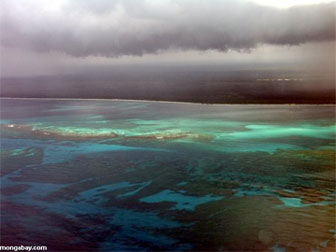|
|
Tropical reefs are easy to destroy and difficult to fix. It is estimated that global warming, unsustainable fishing, and pollution have already destroyed 20% of the world’s coral reefs. Recently, Virginia Garrison and Greg Ward of the United States Geological Survey (USGS) demonstrated how coral fragments that have broken loose during storms can be used to rebuild reefs. They reported their results in the October issue of Biological Conservation.
Garrison and Ward conducted their study in Virgin Islands National Park, on the island of St. John. They took fragments of coral that had been naturally dislodged from healthy reefs during storms. With plastic zip-ties, they re-attached these fragments to other reefs that had lost corals. After five years, the results were promising: 25% of fragments had living coral colonies, and only 31% had died. The remainder has been knocked off by waves.
 |
The majority of successful transplants in this study were Acropora palmate, an endangered Caribbean coral. Acropora palmata and another species in the study, A. cerivcomia, were major parts of the Caribbean reef ecosystem until a major die-off in the 1970s. This earned them the distinction of being the first corals listed as threatened by the US Endangered Species Act.
Garrison and Ward highlight the significant debate about reef restoration. Some biologists have argued that the extent of reef damage is too vast to make restoration worthwhile. In response, Garrison and Ward note the low cost of their approach: $21 per transplant, two-thirds of which is the salary of workers. Other methods of reef restoration include stabilization of reefs, removal of debris that can choke reefs, and the creation of rock piles to encourage the re-establishment of corals.
Citation: Garrison, Virginia and Greg Ward. 2008. Storm-generated coral fragments – a viable source of transplants for reef rehabilitation. Biological Conservation 141: 3089-2100 (October).
Locations in Virgin Islands National Park, St. John: Trunk Cay, Hawksnest Bay, Whistling Cay, Leinster Bay
Species: Acropora palmata, A. cervicornis, Porites porites
A. palmate at NOAA: www.nmfs.noaa.gov/pr/species/invertebrates/elkhorncoral.htm
Bibliography:
Coral Restoration Studies Cited by Garrison and Ward (2008):
Birkeland, C., 2004. Ratcheting down the coral reefs. BioScience
54, 1021–1027.
Bowden-Kerby, A., 2001. Low-tech coral reef restoration methods
modeled after natural fragmentation processes. Bulletin of
Marine Science 69, 915–931.
Briggs, J.C., 2005. Coral reefs: conserving the evolutionary sources.
Biological Conservation 126, 297–305.
Bruckner, A.W., Bruckner, R.J., 2001. Condition of restored Acropora
palmata fragments off Mona Island, Puerto Rico, 2 years after
Fortuna Reefer ship grounding. Coral Reefs 20, 235–243.
Clark, S., Edwards, A.J., 1994. Use of artificial reef structures to
rehabilitate reef flats degraded by coral mining in the
Maldives. Bulletin of Marine Science 55, 724–744.
Clark, S., Edwards, A.J., 1995. Coral transplantation as an aid to
reef rehabilitation: evaluation of a case study in the Maldive
Islands. Coral Reefs 14, 201–213.
Edwards, A.J., Clark, S., 1998. Coral transplantation: a useful
management tool or misguided meddling? Marine Pollution
Bulletin 37, 474–487.
Epstein, N., Bak, R.P.M., Rinkevich, B., 2003. Applying forest
restoration principles to coral reef rehabilitation. Aquatic
Conservation: Marine and Freshwater Ecosystems 13, 387–395.
Fox, H.E., Mous, P.J., Pet, J.S., Muljad, A.H., Caldwell, R.L., 2005.
Experimental assessment of coral reef rehabilitation following
blast fishing. Conservation Biology 19, 98–107.
Gardner, T.A., Cote, I.M., Gill, J.A., Grant, A.,Watkinson, A.R., 2003.
Long-term region-wide declines in Caribbean corals. Science
301, 958–960.
Harriott, V.J., Fisk, D.A., 1988. Coral transplantation as a reef
management option. In: Proceedings of the 6th International
Coral Reef Symposium, pp. 375–379.
Highsmith, R.C., 1982. Reproduction by fragmentation in corals.
Marine Ecology Progress Series 7, 207–226.
Hudson, J.H., Robbin, D.M., Tilmant, J.T., Wheaton, J.W., 1989.
Building a coral reef in SE Florida: combining technology with
aesthetics. Bulletin of Marine Science 44, 1067.
Jaap, W.C., 2000. Coral reef restoration. Ecological Engineering 15,
345–364.
Lindahl, U., 2003. Coral reef rehabilitation through
transplantation of staghorn corals: effects of artificial
stabilization and mechanical damages. Coral Reefs 22, 217–
223.
Maragos, J.E., 1974. Coral transplantation: a method to create,
preserve, and manage coral reefs. Hawaii University Sea Grant
Advanced Report, 35 p.
Plucer-Rosario, G., Randall, R.H., 1987. Preservation of rare coral
species by transplantation and examination of their
recruitment and growth. Bulletin of Marine Science 41, 585–
593.
Raymundo, L.J., 2001. Mediation of growth by conspecific
neighbors and the effect of site in transplanted fragments of
the coral Porites attenuata Nemenzo in the central Philippines.
Coral Reefs 20, 263–272.
Rinkevich, B., 2000. Steps toward the evaluation of coral reef
restoration by using small branch fragments. Marine Biology
136, 807–812.
Smith, L.D., Hughes, T.P., 1999. An experimental assessment of
survival, re-attachment and fecundity of coral fragments.
Journal of Experimental Marine Biology and Ecology 235, 147–
164.
Soong, K., Chen, T.I., 2003. Coral transplantation: regeneration
and growth of Acropora fragments in a nursery. Restoration
Ecology 11, 62–71.
Yap, H.T., 2000. The case for restoration of tropical coastal
ecosystems. Ocean and Coastal Management 43, 841–851.